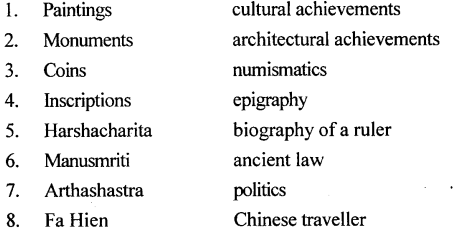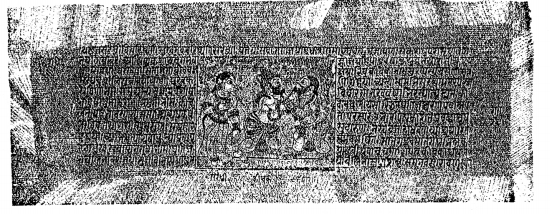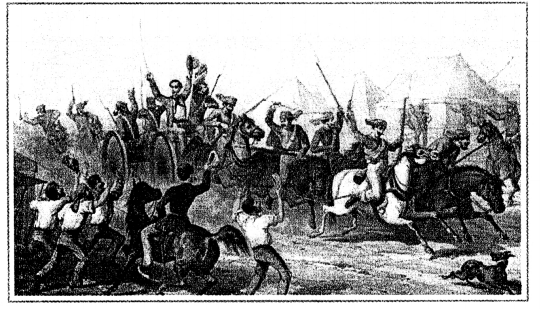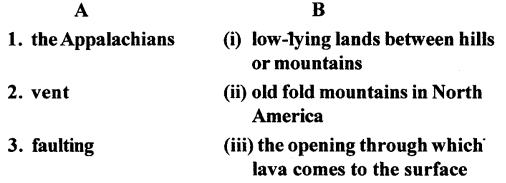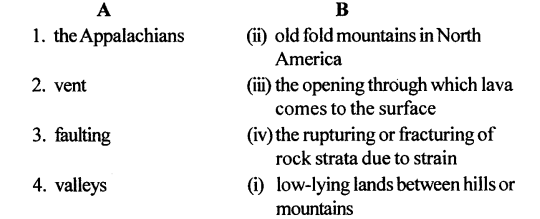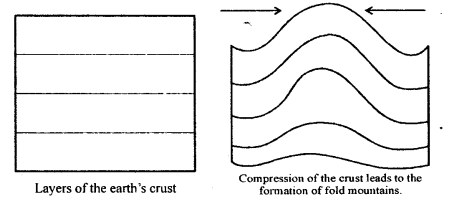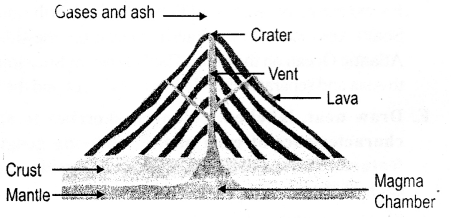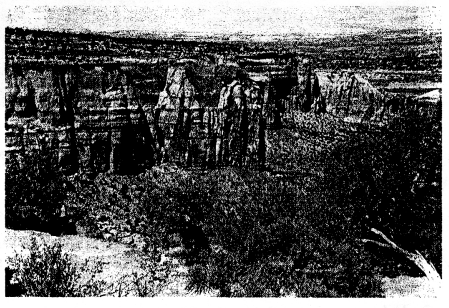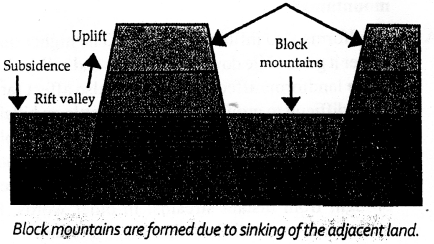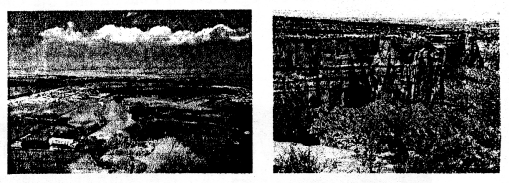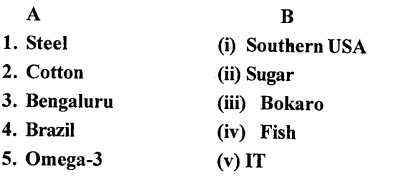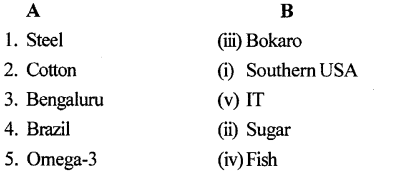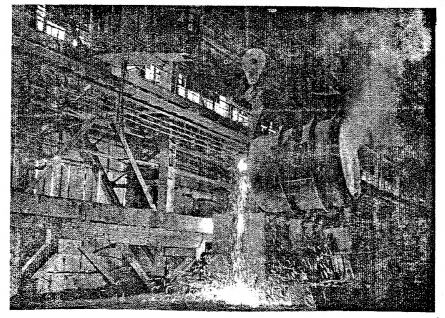ICSE Solutions for Class 8 History and Civics – Traders to Rulers (II)
ICSE SolutionsSelina ICSE SolutionsML Aggarwal Solutions
APlusTopper.com provides step by step solutions for ICSE Solutions for Class 8 History and Civics. You can download the History and Civics ICSE Solutions for Class 8 with Free PDF download option. History and Civics for Class 8 ICSE Solutions all questions are solved and explained by expert teachers as per ICSE board guidelines.
ICSE Solutions Class 8 History & Civics GeographyBiologyChemistryPhysicsMaths
Time To Learn
I. Fill in the blanks:
- The British had to face the challenge of the rulers of Hyderabad and Mysore, Marathas after the conquest of Bengal.
- The new Nizam of Hyderabad, Salabat Jung initially had cordial relations with the English.
- Lord Wellesley made the Nizam of Hyderabad enter the Subsidiary Alliance system.
- The English fought four wars with rulers of Mysore, known as Anglo-Mysore wars.
- It took the British 43 years to defeat the Marathas in three Anglo-Maratha wars.
- Lord Dalhousie annexed Awadh on basis of misgovernance.
II. Match the contents of Column A and Column B:
Column A Column B


Answer:

III. State whether the following statements are True or False:
- The Subsidiary Alliance system was started by Lord Cornwallis.
False. - The capture of the port of Mahe by the British led to the Second Anglo-Mysore War in 1780
True. - Tipu won a great battle against his three enemies, the English, Nizam and the Marathas in 1792
False. - The war of succession among the Marathas in 1772 gave a chance to the English to interfere in Maratha politics.
True. - The Second Anglo-Maratha war was fought when Lord Wellesley was the Governor General of India.
True. - Jhansi and Nagpur were annexed under the pretext of misgovernance.
False.
IV. Answer the following questions:
Question 1.
What were the results of the First Anglo-Mysore War?
Answer:
The Marathas, the Nizam and the British marched towards Mysore. But Hyder won over the Marathas and the Nizam. The British were isolated. Haider won after some setbacks. He forced the British to sign a peace treaty in 1769, according to which both Haider and the British agreed to help each other in case of any attack by a third power.
Question 2.
How did the British force win the Third Anglo-Mysore War?
Answer:
In the Third Anglo-Mysore War (1790-1792) the company won the support of two other powers – the Nizam of Hyderabad and the Marathas. Tipu Sultan was completely defeated by these three joint powers and was forced to sign the Treaty of Seringapattam in 1792. According to the terms of this treaty Tipu had to surrender half of his territories which were to be shared between the British, the Nizam and the Marathas. Tipu also had to pay a war indemnity of ruppees 3.3 crore. Two of his sons were taken hostages.
Question 3.
What were the causes of the Fourth Anglo-Mysore War? What were its results?
Answer:
The Treaty of Seringapattam was short lived. Lord Wellesley, the Governor General wanted the ruler of Mysore, Tipu to accept the Subsidiary Alliance but Tipu refused to do so. Tipu sought French help. The British feared that the French might land in support of Tipu. So in 1799, the British went to war against Tipu. The Nizam joined the British but the Marathas remained neutral and the French support never came. Tipu was killed in the battle on 4th May 1799.
Question 4.
Name the four different centres of Maratha power.
Answer:
The four different centres of Maratha power were Bhonsle at Nagpur, Scindia at Gwalior, Peshwa at Pune and Holkar at Indore.
Question 5.
What were the causes and results of the First Anglo-Maratha War? When was it fought?
Answer:
In 1772, a war of succession followed for the seat of Peshwaship after the death of Peshwa Madhav Rao I between Raghoba and Madhav Rao II. The English sided with Raghoba. Marathas led by Nana Phadnavis supported Madhav Rao II. An indecisive war broke out and continued for seven years. It ended in 1782 with the signing of the Treaty of Salbai. Under this Madhav Rao II was recognised as Peshwa and the Marathas had to cede Salsette. Peace prevailed between the Marathas and the British for 20 years.
Question 6.
Who was the Governor-General of India during the Second Anglo-Maratha War? What was the significance of this battle?
Answer:
The Second Anglo-Maratha War was fought when Lord Wellesley was the Governor General of India. In 1803 Baji Rao II signed with the English East India Company a Subsidiary Alliance known as Treaty of Bassein. As a result the English installed Baji Rao II at Pune and helped to drive out the Holkars. The Maratha chiefs Scindia and Bhonsle refused to accept the system of Subsidiary Alliance and declared war against the British. But the British defeated the combined forces of Scindia and Bhonsle. They were forced to enter into the Subsidiary Alliance with the English. They ceded the territories of Ahmednagar, Broach, Cuttack and Balasore. This war gave a blow to the power and prestige of the Marathas.
Question 7.
Why was the Third Anglo-Maratha War fought? What were its results?
Answer:
The Third Anglo Maratha War was fought in (AD 1817-1818) because the Maratha chiefs were feeling humiliated after signing the Subsidiary Alliance with the British. Peshwa Baji Rao II began to make plans to unite the Marathas against the British. This war was fought during the Governor Generalship of Marquess Hastings. When Lord Hastings became aware of Baji Rao’s plans he forced him to sign the Treaty of Pune in 1817. According to it, Konkan was ceded and Baji Rao II renounced Maratha leadership. Scindia was forced to sign the Treaty of Gwalior and provide help to the British against the Pindaris.
The Marathas made their last attempt to regain their old prestige and independence. They declared war against English. Baji Rao II raised a huge army and attacked the British Residency at Poona in 1817. The war continued for about two years. Finally the Marathas were defeated and large parts of their territories were annexed by the British.
The Third Anglo – Maratha War led to the abolition of Peshwa’s hereditary office. The Maratha dream of building a Hindu empire was completely shattered and the British emerged as the unchallenged power in India.
Question 8.
State very briefly why the Marathas failed against the British.
Answer:
The Marathas were inferior to the English in material sources, military organisation, diplomacy and leadership. The Maratha state was despotic and feudal. It was a loose confederation of different powers – the Holkar, Bhonsle, Scindhia – headed by the Peshwa. The Marathas were careless about military intelligence whereas the British had superior espionage system. The Marathas did not possess any national sentiment. The internal jealously and selfish treachery among them triumphed over national interest. The Marathas lacked men of talent and leadership in later years. They were in disarray in all aspects.
Question 9.
Explain the doctrine of Lapse. Name the other methods used by Lord Dalhousie to expand the British power in India.
Answer:
According to Doctrine of Lapse if the ruler of a dependent state died without leaving a natural heir the state would automatically pass over to the British. The Doctrine of Lapse did not recognise adopted children as rightful heirs. Satara, Jaitpur, Baghat, Udaipur, Sambhalpur, Jhansi and Nagpur were annexed under the Doctrine of Lapse. Punjab was annexed through war. Awadh was annexed by Dalhousie on the basis of misgovemance.
V. Word Hunt
Given below is a grid. Look for names of places which Dalhousie annexed. You have to look vertically, horizontally and diagonally. In total there are 8 places. After you have found out these places, write down why these were annexed.
Answer:
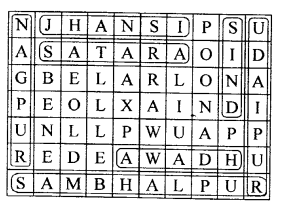
VI. Picture Study –
This is a picture depicting the first Anglo-Sikh War.
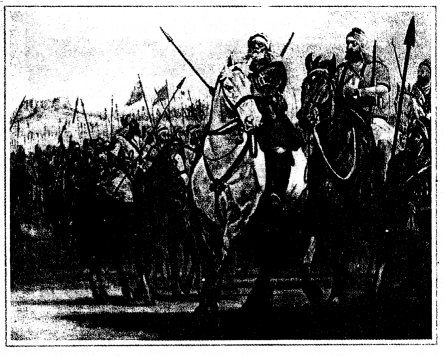
Question 1.
What was the political condition of Punjab after the death of Maharaja Ranjit Singh?
Answer:
After the death of Maharaja Ranjit Singh there was a state of political instability in the Punjab. For six years there was conflict among various claimants to the throne.
Question 2.
When was the first Anglo-Sikh war fought?
Answer:
First Anglo Sikh War was fought in December 1845.
Question 3.
What were the causes and results of the First Anglo-Sikh War?
Answer:
The mother of the minor son of Ranjit Singh, Maharani Jindan Kaur instigated the Khalsa against the British. This led to the first Anglo-Sikh War.
The Sikhs were defeated and had to sign the Treaty of Lahore in 1846. The Sikhs lost territory and had to keep British Resident.
Additional Questions
Rise of British Power in Bengal
A. Fill the in the blanks:
- Madras, Bombay and Calcutta became the headquarters of the British settlements in the southern, western and eastern regions, respectively.
- In 1717, the Mughal emperor granted the United East India Company the right to carry on duty-free trade in Bengal, Bihar and Orissa.
- The French East India Company was established in 1664 C.E.
- The British and the French fought the Carnatic Wars in India to establish their monopoly in trade.
- Bengal in the 18th century was the richest and the most fertile province in India.
- In 1757 Robert Clive recovered Calcutta which had been captured by Siraj-ud-Daulah in 1756.
- Mir Jafar was deposed because he was unable to meet the demands of the British.
- In 1765, Awadh was returned to Shuja-ud-Daulah but Kora and Allahabad were taken away and given to Shah Alam II.
- Shah Alam II granted the Company the Diwani of Bengal, Bihar and Orissa in 1765.
- Warren Hastings deposed and pensioned off the Nawab of Bengal and brought Bengal under the direct, and complete control of the Company.
B. Match the following:
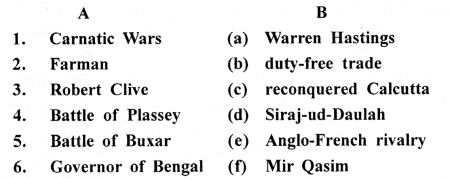
Answer:
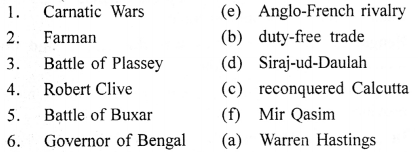
C. Choose the correct answer:
Question 1.
The English East India Company was established in the year 1600/1700/1800 CE.
Answer:
The English East India Company was established in the year 1600.
Question 2.
The English East India Company set up its first factory in Surat/Agra/Broach.
Answer:
The English East India Company set up its first factory in Surat.
Question 3.
The largest and the most prosperous European settlement in Bengal was the British settlement at Calcutta/Burdwan/ Murshidabad.
Answer:
The largest and the most prosperous European settlement in Bengal was the British settlement at Calcutta.
Question 4.
Alivardi Khan was succeeded by Mir Qasim/Siraj-ud- Daulah/Shuja-ud-Daula.
Answer:
Alivardi Khan was succeeded by Siraj-ud-Daulah.
Question 5.
Robert Clive hatched a plot with Mir Jafar/Mir Qasim/ Alivardi Khan to replace Siraj-ud-Daulah.
Answer:
Robert Clive hatched a plot with Mir Jafar to replace Siraj- ud-Daulah.
Question 6.
The Battle of Plassey was fought in 1757/1764/1772.
Answer:
The Battle of Plassey was fought in 1757.
Question 7.
The Dual Government in Bengal was introduced by Robert Clive/Warren Hastings/Lord Cornwallis.
Answer:
The Dual Government in Bengal was introduced by Robert Clive.
D. State whether the following are true or false:
- The Carnatic Wars were fought between the British and the French.
True. - The employees of the Company were entitled to both private trade as well as duty-free trade.
False.
Correct: The employees of the Company were permitted to carry on private trade but they were not entitled to the Company’s privilege of duty-free trade. - The English East India Company was given the right to issue passes or dastaks for the free movement of their goods.
True. - The British army was defeated in the Battle of Buxar.
False
Correct : The British army won in the Battle of Buxar. - The Treaty of Allahabad was signed between the British Company and Mir Qasim.
False.
Correct: The Treaty of Allahabad was signed between the British and Shuja-ud-Daulah. - Warren Hastings laid the foundation of an organized system of government in Bengal.
True.
Answer the following questions in one or two words/ sentences:
Question 1.
Who granted the English East India Company the exclusive right to trade with the East ?
Answer:
The Queen of England, Elizabeth I, granted the Company the exclusive right to trade with the East.
Question 2.
Name the British trading settlements in
(a) Madras (b)Calcutta
Answer:
(a)
Madras was given to the British by a local ruler. They established a trading settlement which they fortified and named Fort St. George.
(b)
Calcutta In 1690 CE, a British trading settlement was established and fortified in Calcutta. It was named Fort William.
Question 3.
What important right did the Mughal emperor Farrukhsiyar grant the English East India Company ?
Answer:
In 1717, the Mughal Emperor, Farrukhsiyar, granted the Company the right to carry on duty-free trade in Bengal, Bihar and Orissa (now Odisha). The Company made enormous profits.
Question 4.
Why were European traders attracted to the Bengal province inthe 18th century?
Answer:
Bengal was the richest and the most fertile province in India at that time. It was known as the paradise of the earth and this province attracted traders from many European countries.
Question 5.
What privileges did the farman of 1717 confer on the English East India Company?
Answer:
By the ‘Farman” of 1717, the English East India company was granted the right to carry on duty-free trade in Bengal. They were allowed to export and import goods from and to Bengal without paying any taxes to the government. They were given the right to issue passes or dastaks for the free movement of their goods.
Question 6.
Why did the farman of 1717 become a bone of contention between the nawabs of Bengal and the British Company?
Answer:
The Nawabs of Bengal wanted British company to pay taxes on trade like the Indians. But the Britishers refused to do so. This created conflict between both the parties and resulted in wars between both of them.
Question 7.
Why did the British fortify their trade settlement in Calcutta?
Answer:
Siraj-ud-Daulah ordered the British to pay taxes to him like all other Indian merchants. The British refused to do so. This angered the young nawab. In anticipation of a war with the French, who had a trading settlement in Chandemagore, the British began to fortify Calcutta.
Question 8.
Why did Siraj-ud-Daulah attack Calcutta in 1756?
Answer:
When the Britishers tried to fortify Calcutta, Siraj-ud-Daulah ordered both the British and the French to dismantle their fortifycations and not to fight private wars on his territory. The French agreed but the British refused. This enraged the Nawab and he attacked Calcutta with a large army and captured Fort William.
Question 9.
What important trading right was granted to the English East India Company after its victory in the Battle of Plassey?
Answer:
- The English East India Company was granted the undisputed right to free trade in Bengal, Bihar and Orissa.
- The Company was given the zamindari of the 24 Parganas.
Question 10.
State the political significance of the Battle of Buxar.
Answer:
- It gave them political influence and control over Awadh and the Mughal emperor.
- It laid the foundation of British rule in India.
Question 11.
Name the Indian signatories of the Treaty of Allahabad.
Answer:
Shuja-ud-Daulah and Shah Alam II
Question 12.
In which year was the Dual Government abolished and by whom?
Answer:
In 1772, Warren Hastings abolished the Dual Government.
F.Answer the following questions briefly:
Question 1.
The Battle of Plassey was a major turning point in the history of India. In this context answer the following questions:
(a) Give an account of the events leading from the conspiracy to replace Siraj-ud-Daulah to his eventual defeat in the Battle of Plassey.
(b)State the results of the Battle of Plassey.
(c) Why is this battle considered a major turning point in the history of India?
Answer:
(a)
A major part of the nawab’s army under the command of Mir Jafar did not take any part in the battle. Realizing that he had been betrayed, the nawab fled from the battlefield. He was captured and put to death.
(b)
Results of Battle of Plasey:
- The English East India company was granted the undisputed right to free trade in Bengal, Bihar and Orissa.
- The Company w’as given the zamindari of the 24 parganas.
- Mir Jafar paid the Company and its officials over 300 lakh rupees.
(c)
The Battle of Plassey was a major turning point in the histoiy of India.
- It paved the way for the establishment of British rule in Bengal and, eventually, the rest of India.
- It transformed a trading company into a political power.
It provided the British the vast resources of Bengal, which helped them to win the Third camatic war and other expeditions in India.
Question 2.
Mir Qasim was a competent ruler, determined to free himself from foreign control. In this context answer the following:
(a) What steps did Mir Qasim take to strengthen his position? Why did he abolish all duties on internal trade?
(b) Trace the events from the outbreak of war (1763) between Mir Qasim and the British up to the Battle of Buxar in 1764.
(c) Explain the importance of the Battle of Buxar.
Answer:
(a)
To strengthen his position, Mir Qasim improved the financial position of Bengal and raised a modern, disciplined and well-equipped army trained by the Europeans.The employers of the company misused their trade privileges. They sold their duty-free trade points to Indian merchants who also used them to carry on duty-free trade. This deprived the Nawab fo large revenues. To put an end to the corrupt practices of the British, Mir Qasim abolished all duties on internal trade.
(b)
The employees of the Company misused their trade privileges. They sold their duty-free trade permits to Indian merchants who also used them to carry on duty-free trade. This deprived the nawab of large revenues and was unfair to those local merchants who had to pay heavy duties.
To put an end to the corrupt practices of the British, Mir Qasim abolished all duties on internal trade. This made the British furious. They refused to accept an equal status with the Indian merchants.
In 1763, war broke out between Mir Qasim and the British. The nawab was defeated. Mir Jafar was reinstated on the throne.
Mir Qasim was determined to recover his throne. He escaped to Awadh, where he formed an alliance with Shuja-ud- Daulah, the nawab of Awadh, and the Mughal emperor, Shah Alam II.
The combined forces of the three allies clashed with the Company’s troops at Buxar in 1764, and were decisively defeated by the British.
(c)
- The victory of the British in the Battle of Buxar firmly established them as masters of Bengal, Bihar and Orissa.
- It gave them political influence and control over Awadh and the Mughal emperor.
- It laid the foundation of British rule in India.
- At this time, Robert Clive returned to India as the governor of Bengal.
Question 3.
With reference to the Treaty of Allahabad and its impact,answer the following:
(a) Mention the terms of agreement between Robert Clive and Shuja-ud-Daulah in this treaty.
(b) Explain how the treaty between Robert Clive and the Mughal emperor Shah Alam II legalized the English East India’s Company’s control over Bengal.
(c) Give an account of the events that followed the death of Mir Jafar, leading to the establishment of the Company as the real ruler of Bengal.
Answer:
(a)
- Awadh was returned to Shuja-ud-Daulah. However, the two districts of Kora and Allahabad were taken away from the Nawab.
- The nawab of Awadh had to pay a war indemnity of 50 lakh rupees to the Company.
- The British agreed to defend the nawab of Awadh against his enemies. The nawab would have to pay for the cost of the British troops. Awadh became a buffer state between the British possessions in Bengal and the Marathas.
(b)
The British gave Shah Alam II the districts of Kora and Allahabad and an annual pension of 26 lakh rupees. In return, the emperor (the nominal head of the Mughal empire) granted the Company the Diwani of Bengal, Bihar and Orissa, e., the right to collect revenue from these provinces and judge civil cases. The Company’s control over Bengal was made legal.
(c)
After Mir Jafar’s death in 1765, his son was made-the nawab of Bengal. He had to sign a treaty with Clive,according to which he had to disband most of his army. He also had to transfer the ‘Nizamat’ powers (general administration and criminal justice) to a deputy nawab appointed by the British. The deputy nawab could not be dismissed by the nawab. The nawab was given an allowance of 53 lakh rupees which was subsequently reduced. Thus, the English East India Company became the real ruler of Bengal from 1765.
Question 4.
With reference to the establishment of Dual Government in Bengal (1765-72) answer the following:
(a) Why was the government introduced in Bengal by Robert Clive referred to as ‘Dual Government’?
(b) What were the advantages and disadvantages of this system for the Company and the nawab respectively?
(c) The evils of the Dual Government led to the collapse of the administration and the economy. Explain.
Answer:
(a)
Robert Clive introduced Dual Government in Bengal in 1765. Bengal now had two masters-the nawab and the Company. The Nawab was responsible for general administration, maintenance of law and order and justice (i.e., criminal cases). The Company had military power and the right to collect and use the revenue of Bengal. This arrangement was known as Dual Government.
(b)
The Company enjoyed power without any responsibilities. The nawab, on the other hand, was burdened with the responsibility of administration without the resources necessary for running it efficiently e., responsibility without power.The revenue was collected by Indian officials appointed by the Company. The greed, corruption and oppression of these officials reduced the peasants to conditions of utter misery. The Company took no interest in the welfare of the people.
(c)
The conditions of the people worsened when Bengal was hit by a terrible famine in which one third of the population perished. Nobody cared, neither the Company nor the nawab, who in any case had neither the authority nor the resources to lessen the miseries of the people. The Company, through its power to nominate the deputy nawab, only interfered in the general administration without assuming any responsibility.The evils of the Dual Government began to manifest themselves. The administration and economy collapsed. In 1772, the Court of Directors of the Company appointed Warren Hastings as the Governor of Bengal. In 1773, by the Regulating Act, he was made the Governor General of British territories in India. The Governor General was now the most important functionary of the East India Company.
G Picture Study.
This picture portrays a momentous event in 1765, involving a British Governor and a Mughal emperor wherein the Mughal emperor is conveying the grant of the Diwani to the governor.

- Identify the Mughal emperor and the British governor
Ans. Mughal Emperor – Shuja-ud-Daulah, British Governor – Robert Clive - What is the significance of this grant of the Diwani?
Ans. The significance of granting the company the Diwani i.e. the right to collect revenue from these provinces and judge civil cases. - Give a brief account of the battle that preceded this event. When did it take place?
Ans. Battle of Buxar in 1764. - What is the importance of this battle?
Ans. Mir Qasim was defeated and Mir Jafar was reinstated on the throne.
Additional Questions
Expansion of British Power in India
EXERCISES
A. Fill the in the blanks:
- The five centres of Maratha power were:
Ans.
The five centres of Maratha power were:- The Sindhias of Gwalior
- The Holkars of Indore
- The Bhonsle family of Nagpur
- The Gaekwad family of Baroda
- The Peshwa of Poona (Pune)
- The Governors-General during the First and Second Anglo- Maratha Wars were Warren Hastings and Lord Wellesley, respectively.
- The Second Anglo-Maratha War was a severe blow to the Sindhia and Bhonsle of the Marathas.
- Lord Dalhousie adopted three methods to make the British the paramount power in India.
- Jhansi was annexed by Dalhousie on the basis of the Doctrine of Lapse.
- Dalhousie annexed Awadh on the grounds of Maladministration or Misgovernment.
B. Match the following:
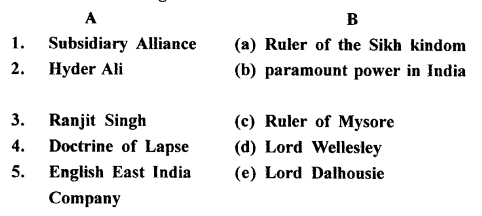
Answer:
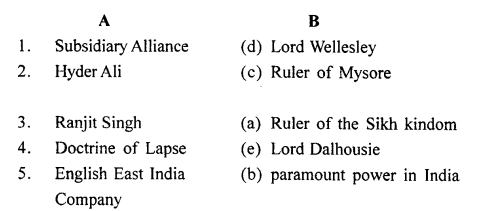
C. Choose the correct answer:
- The First Anglo-Maratha War was fought during the Governor-Generalship of Lord Cornwallis/Lord Wellesley/ Warren Hastings.
Ans. The First Anglo-Maratha War was fought during the Governor- Generalship of Warren Hastings. - The Maratha chiefs were united under the leadership of Nana Phadnavis/Baji Rao II/Madhav Rao II during the First Anglo-Maratha War.
Ans. The Maratha chiefs were united under the leadership of Nana Phadnavis during the First Anglo-Maratha War. - After the Third Anglo-Maratha War the British placed a descendant of Shivaji on the throne of Nagpur/Satara/Jhansi.
Ans. After the Third Anglo-Maratha War the British placed a descendant of Shivaji on the throne of Satara. - Punjab was annexed by Lord Minto/Lord Dalhousie/Lord Wellesley in 1849.
Ans. Punjab was annexed by Lord Dalhousie in 1849. - The widespread resentment against annexations expressed itself in the Revolt of 1849/1861/1857.
Ans. The widespread resentment against annexations expressed itself in the Revolt of 1857
D. State whether the following are true or false:
- After Hyder Ali’s death, his son Tipu Sultan continued the Anglo-Maratha Wars.
True. - The Subsidiary Alliance system was used by the British to bring Indian rulers under British control without any war.
True. - The Subsidiary Alliance proved very advantageous for the Indians.
False.
Correct : The Subsidiary Alliance proved very advantageous for the British. - The adopted son of Peshwa Baji Rao II was denied the pension that his father used to get from the British.
True. - By 1856, the English East India Company had brought the whole of India under its control.
True.
E. Answer the following questions in one or two words/ sentences:
Question 1.
What was the main objective of the Subsidiary Alliance system?
Answer:
The subsidiary Alliance system was a method perfected by Lord Wellesley to subjugate Indian powers without the cost and bother/ trouble of war.Any Indian ruler whose security was threatened was encouraged to seek help from and enter into an alliance with the British, who promised to protect the ruler from external attacks and internal revolts. The Indian ruler had to accept certain terms and conditions. ‘
Question 2.
What happened when the administration of a subsidiary state collapsed?
Answer:
When the administration collapsed, the British used it as an excuse for annexing the kingdom on grounds of misgovemment.
Question 3.
Why did Peshwa Baji Rao II sign the Subsidiary Alliance?
Answer:
In 1802, Peshwa baji Rao II, supported by Sindhia, was defeated by Holkar. Baji Rao II fled to Bassein where he signed the Subsidiary Treaty as a price for British protection and support. He was escorted back to Poona by British soldiers.
Question 4.
Why was Wellesley recalled from India during the Second Anglo-Maratha War?
Answer:
Wellesley was recalled from India because the government in England was unhappy with the enormous expenditure involved in Wellesley’s policy of wars and expansion.
Question 5.
How did the Subsidiary Alliance impact the
(a) economy
(b) administration in Awadh?
Answer:
(a)
Awadh had signed a Subsidiary Alliance with Wellesley. He had to protect the nawab from external invasions and internal rebellions. It made the nawabs complacent and unconcerned about the affairs of the state. The payement of annual subsidies to the Company exhausted the state treasury
(b)
When the administration was on the verge of collapse, Dalhousie struck. He brought charges of misgovemment or maladministration against the nawab. On those grounds he deposed the nawab and annexed Awadh in 1856.
F. Answer the following questions briefly:
Question 1.
With reference to the Subsidiary Alliance System perfected by Lord Wellesley, answer the following:
(a) Why did Indian rulers sign the Subsidiary Alliance? State two important military terms and conditions imposed on the Indian rulers by this treaty.
(b) The Subsidiary Alliance proved very beneficial for the British. Explain.
(c) Discuss the disastrous effects of the Subsidiary Alliance on the Indian states.
Answer:
(a)
Indian ruler whose security was threatened was encouraged to seek help from and enter into an alliance with the British,who promised to protect the ruler from external attacks and internal revolts. The Indian rulers had to accept certain terms and condition in return for
British protection under the Subsidiary Alliance like:
- British troops would be permanently placed in the territory of the Subsidiary state.
- The ruler would have to pay for the maintenance of the troops.
- He could not employ any europeans in his service or dismiss those who were already there.
- He could not form an alliance with any other power or declare war against any power without the permission of the British.
- He would acknowledge the British Company as the paramount power.
(b)
The Subsidiary Alliance proved very advantageous for the British like.
- The British maintained large armies at the expense of the Indian rulers.
- The British acquired valuable territories as subsidiary payment. This led to the expansion of the
- British empire in India and an increase in its resources.
- The influence of European rivals, especially the French, was excluded from the courts of the Indian rulers.
- The British controlled the foreign policy of the Subsidiary states.
(c)
The Subsidiary Alliance System had great effect on the subsidiary state like:
- British troops would be permanently placed in the territory of the Subsidiary state.
- The ruler would have to pay for the maintenance of the troops.
- He could not employ any Europeans in his service or dismiss those who were already there.
- He could not form an alliance with any other power or declare war against any power without the permission of the British. ‘
- He would acknowledge the British Company as the paramount power.ses or dastaks for the free movement of their goods.
Question 2.
Dalhousie was a great expansionist and adopted a number of methods to build an all-India empire. In this context, answer the following questions:
(a) Mention the various methods adopted by Dalhousie and the territories annexed on the basis of these methods.
(b) Under what circumstances did a subordinate state automatically ‘lapse’ and pass into the hands of the British? How did the rulers react to this policy?
(c) Why did Nana Saheb become one of the leaders of the Revolt of 1857?
Answer:
(a)
Dalhousie adopted a number of methods to give the final touches to the work of empire-building in India. The methods he adopted were:
- War-Punjab.
- Doctrine of Lapse-Satara, Jhansi and Nagpur.
- Annexation on grounds of maladministration-Awadh.
(b)
Lord Dalhousie brought several subordinate states under the direct rule of the Company by annexing them on the basis of the Doctrine of Lapse. According to the Doctrine of Lapse, all subordinate states (subsidiary states and states created by the British) where the rulers died without a natural male heir would automatically ‘lapse’, e., pass into the hands of the British. Rulers without heirs could not adopt sons, according to the age-old Hindu and Islamic traditions, without the permission of the Company.
(c)
Nana Saheb, the adopted son of Peshwa Baji Rao II, inherited his father’s personal property but was not given the pension that had been paid to his father. Nana Saheb became one of the important leaders of the Revolt of 1857.
Question 3.
With reference to the annexation of Awadh discuss:
(a) The effects of the Subsidiary Alliance on the administration in Awadh
(b)The political scenario in India by 1856
(c) Any three factors responsible for the success of the British over their Indian rivals
Answer:
(a)
Awadh had signed Subsidiary Alliance with Wellesley. He had to protect the nawab from external invasions and internal rebellions. It made the nawabs complacent and unconcerned about the affairs of the state. The payement of annual subsidies to the Company exhausted the state treasury. When the administration was on the verge of collapse, Dalhousie struck. He brought charges of misgovemment or maladministration against the nawab. On these grounds he deposed the nawab and annexed Awadh in 1856.
(b)
By 1856 the English East India Company had brought the whole of India under its control of the British. The British had eliminated all their rivals and established themselves as the paramount power in India.
(c)
The factors responsible for the success of the British are:
- Lack of unity among Indian rulers.
- Lack of organized and efficient administration in Indian states.
- Superior military resources of the company.
- Superior economic resources of the company.
- Naval supremacy of the British.
G Picture study:
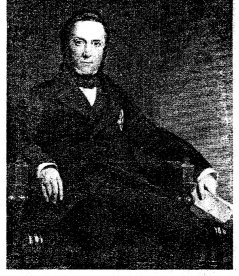
- Name the Governor General.
Ans. Lord Dalhousie - What was the method adopted by him to subjugate the Indian territories ?
Ans. Governor General Dalhousie was a great imperialist who annexed several states on the basis of the Doctrine of Lapse. - Mention the terms and conditions under this method.
Ans. According to the Doctrine of Lapse, all subordinate states
(subsidiary states and states created by the British) where the rulers died without a natural male heir would automatically ‘lapse’, i.e. pass into the hands of the British. Rulers without heirs could not adopt sons, according to the age-old Hindu and Islamic traditions, without the permission of the Company. - Did this method have any advantage for the Indian rulers? Why ?
Ans. The annexation of these states caused widespread resentment among the Indian rulers and became a potent factor responsible for the outbreak of the Revolt of 1857.


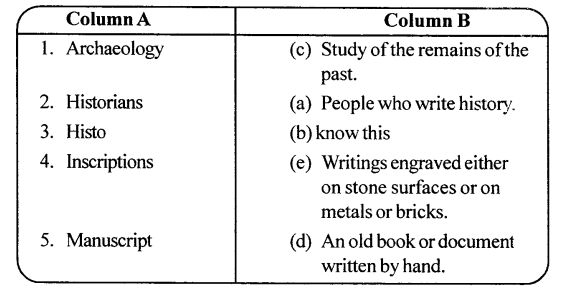
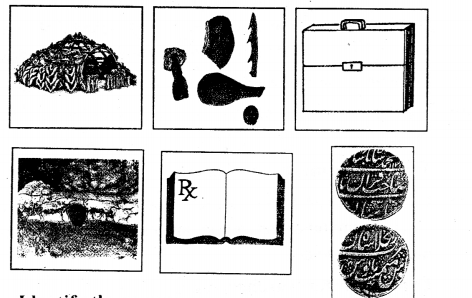
![]()

